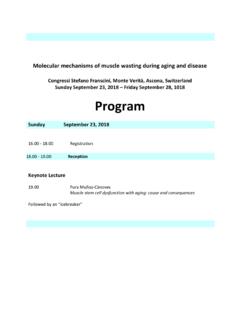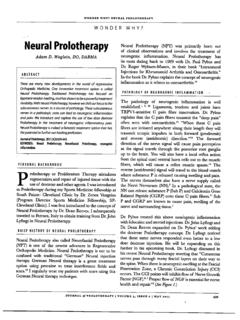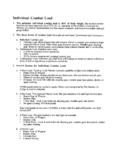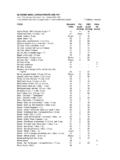Transcription of Overuse Tendinosis, Not Tendinitis - Massage by Joel
1 Overuse tendinosis , Not Tendinitis Part 1: A New Paradigm for a Difficult Clinical Problem Karim M. Khan, MD, PhD; Jill L. Cook, B App Sci, PT; Jack E. Taunton, MD; Fiona Bonar, MBBS, BAO THE PHYSICIAN AND SPORTSMEDICINE - VOL 28 - NO. 5 - MAY 2000 This is the first of two articles on tendinopathies by Dr Khan and colleagues; the second, on patellar tendinopathy, will appear in a subsequent issue. In Brief: Overuse tendinopathies are common in primary care. Numerous investigators worldwide have shown that the pathology underlying these conditions is tendinosis or collagen degeneration.
2 This applies equally in the Achilles, patellar, medial and lateral elbow, and rotator cuff tendons. If physicians acknowledge that Overuse tendinopathies are due to tendinosis , as distinct from Tendinitis , they must modify patient management in at least eight areas. These include adaptation of advice given when counseling, interaction with the physical therapist and athletic trainer, interpretation of imaging, choice of conservative management, and consideration of whether surgery is an option. Physicians in primary care, sports medicine, and orthopedics see patients with Overuse tendon conditions nearly every day.
3 Tendon conditions are not restricted to competitive athletes but affect recreational sports participants and many working people, particularly those doing manual labor (1). Unfortunately, these disorders are not only common, they can also be recalcitrant to treatment. One factor that may interfere with optimal treatment is that common tendinopathies may be mislabeled as Tendinitis . Advances in the understanding of tendon pathology indicate that conditions that have been traditionally labeled as Achilles Tendinitis , patellar Tendinitis , lateral epicondylitis, and rotator cuff Tendinitis are in fact tendinosis .
4 An increasing body of evidence supports the notion that these Overuse tendon conditions do not involve inflammation. If this is correct, then the traditional approach to treating tendinopathies as an inflammatory " Tendinitis " is likely flawed. The recommendations presented here reflect the current scientific data and will help physicians avoid common misconceptions about tendinopathies and their management (table 1) (2-11). TABLE 1. Common Misconceptions About Tendinopathies and Their Management Misconception Evidence-Based Finding Tendinopathies are self-limiting conditions that take only a few weeks resolve (2) Tendinopathies often prove recalcitrant to treatment and may take months to resolve Imaging appearance can predict prognosis Imaging does not predict prognosis.
5 It adds to the likelihood of a diagnosis of tendinopathy but does not prove it (3-5) Cyst-like ultrasonographic abnormalities in tendons are indications for surgery Surgery should be based on clinical grounds; cyst-like ultrasonographic findings can be found in asymptomatic athletes (5) Surgery provides rapid relief of symptoms in almost all subjects After surgery, return to sport takes a minimum of 4-6 mo (6-11); not all patients do well (8,9) tendinosis : A Noninflammatory Disorder Pathology. The pathology of the major tendinopathies has been well described and is based on examination of surgical specimens.
6 In studies of the Achilles (11), patellar (12), lateral elbow (9,13), medial elbow (14), and rotator cuff tendons (15), tissue appeared remarkably consistent. Macroscopically, abnormal tissue examined at surgery shows the tendon to be dull-appearing, slightly brown, and soft. Normal tendon tissue is white, glistening, and firm. When examined under a light microscope, abnormal tendon from patients with chronic tendinopathies differs from normal tendon in several key ways. It has a loss of collagen continuity (figure 1) and an increase in ground substance, vascularity, and cellularity (figure 2: not shown).
7 Cellularity results from the presence of fibroblasts and myofibroblasts (figure 3: not shown), not inflammatory cells. Thus, in patients who have chronic Overuse tendinopathies, inflammatory cells are absent. tendinosis vs Tendinitis . Key features of tendinosis are described in table 2. Tendinitis is a rather rare condition but may occur occasionally in the Achilles tendon in conjunction with a primary tendinosis . Paratenonitis, one of the disorders in the differential diagnosis, is a condition of inflammation of the outer layer of the tendon (paratenon) alone, whether or not the paratenon is lined by synovium.
8 It is commonly associated with intratendinous degeneration (16) and produces the "crepitus" that is easily felt in some cases of Achilles paratenonitis. Unfortunately, distinguishing tendinosis from the rare Tendinitis is difficult clinically. But because tendinosis is far more likely, our advice is to treat patients initially as if tendinosis were the diagnosis. TABLE 2. Bonar's Classification of Overuse Tendon Conditions (17) Pathologic Diagnosis Macroscopic Pathology Histologic Finding tendinosis Intratendinous degeneration commonly due to aging, microtrauma, or vascular compromise Collagen disorientation, disorganization, and fiber separation by increased mucoid ground substance, increased prominence of cells and vascular spaces with or without neovascularization, and focal necrosis or calcification Partial rupture or Tendinitis Symptomatic degeneration of the tendon with vascular disruption.
9 Inflammatory repair response Degenerative changes as noted above with superimposed evidence of tear, including fibroblastic and myofibroblastic proliferation, hemorrhage, and organizing granulation tissue Paratenonitis Inflammation of the outer layer of the tendon (paratenon) alone whether or not the paratenon is lined by synovium Mucoid degeneration is seen in the areolar tissue: a scattered mild mononuclear infiltrate with or without focal fibrin deposition and fibrinous exudate Paratenonitis with tendinosis Paratenonitis associated with intratendinous degeneration Degenerative changes as noted in tendinosis with mucoid degeneration with or without fibrosis and scattered inflammatory cells in the paratenon alveolar tissue tendinosis as a concept.
10 Although recent research has clearly demonstrated the presence of tendinosis in chronically injured tendon tissue, this is not a new discovery (17). The term tendinosis was first used by German researchers in the 1940s; the term's recent usage results from Puddu et al (18) and Nirschl and Pettrone (9). Writing about tendinopathies in 1986, Perugia et al (19) noted the "remarkable discrepancy between the terminology generally adopted for these conditions (which are obviously inflammatory since the ending 'itis' is used) and their histopathologic substratum, which is largely degenerative.





